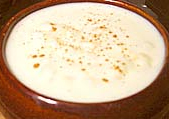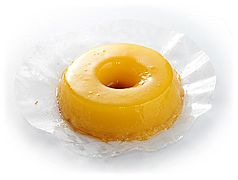
Dessert is a course that concludes a meal. The course consists of sweet foods, such as cake, biscuit, ice cream and possibly a beverage such as dessert wine and liqueur. Some cultures sweeten foods that are more commonly savory to create desserts. In some parts of the world there is no tradition of a dessert course to conclude a meal.

Brazilian cuisine is the set of cooking practices and traditions of Brazil, and is characterized by European, Amerindian, African, and Asian influences. It varies greatly by region, reflecting the country's mix of native and immigrant populations, and its continental size as well. This has created a national cuisine marked by the preservation of regional differences.
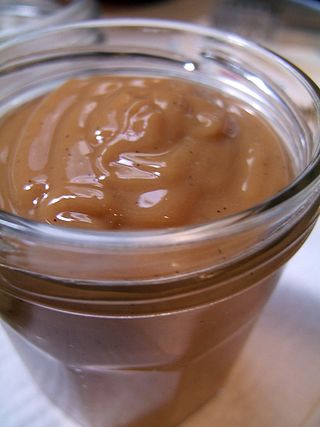
Dulce de leche, caramelized milk, manjar, milk candy or milk jam is a confection popular in Latin America, France, Poland and the Philippines prepared by slowly heating sugar and milk over a period of several hours. The resulting substance, which takes on a spreadable, sauce-like consistency, derives its rich flavour and colour from non-enzymatic browning. It is typically used to top or fill other sweet foods.

The brigadeiro is a traditional Brazilian dessert. The origin of the dessert is uncertain, but the most common theory is that it was created by a confectioner from Rio de Janeiro, Heloisa Nabuco de Oliveira, to promote the presidential candidacy of Eduardo Gomes. It is made of condensed milk, cocoa powder, butter, and chocolate sprinkles covering the outside layer.

Colombian cuisine is a culinary tradition of the six main regions within Colombia. Colombian cuisine varies regionally and is influenced by Indigenous Colombian, Spanish, and African cuisines, with slight Arab influence in some regions.

Rocky road is a type of no-bake slice made up of milk chocolate and marshmallows along with other ingredients, which tend to vary by country. In British influenced areas, Rocky Road is a type of tiffin or traybake but the Australian/American name is becoming more common. It is usually served in individual portions such as a brownie, or in American cuisine, as an ice cream flavor.
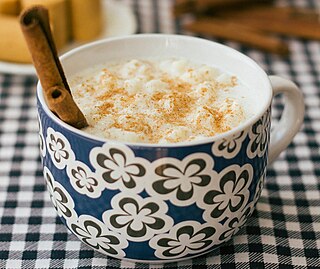
Canjica, mugunzá or mungunzá is a Brazilian sweet dish, associated with winter festivals, which in Brazil is in June.

Beijinho, also known as branquinho, is a typical Brazilian birthday party candy prepared with condensed milk, grated desiccated coconut, rolled over caster sugar or grated coconut and frequently topped with a clove.
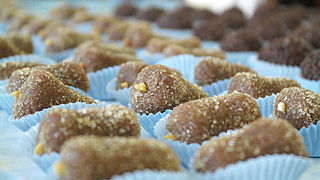
CajuzinhoPortuguese pronunciation:[kaʒu'zĩɲu] is a popular sweet with an almost ubiquitous presences in Brazilian parties. It is made of peanuts, cashew nuts and sugar and is shaped like a tiny cashew, although it does taste strongly of peanut.

Chocolate salami is an Italian and Portuguese dessert made from cocoa, broken biscuits, butter and sometimes alcohol such as port wine or rum. The dessert became popular across Europe and elsewhere, often losing alcohol as an ingredient along the way.

Cocada are a traditional coconut confectionery found in many parts of Latin America and Europe. They are particularly popular in Argentina, Bolivia, Brazil, Colombia, Chile, the Dominican Republic, Cuba, Spain, Mexico, Panama, Venezuela Ecuador And Goa Former Estado da Índia Portuguesa.
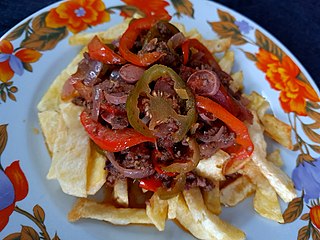
Bolivian cuisine is the indigenous cuisine of Bolivia from the Aymara and Inca cuisine traditions, among other Andean and Amazonian groups. Later influences stemmed from Spaniards, Germans, Italians, French, and Arabs due to the arrival of conquistadors and immigrants from those countries. The traditional staples of Bolivian cuisine are corn, potatoes, quinoa and beans. These ingredients have been combined with a number of staples brought by the Spanish, such as rice, wheat, beef, and pork.

Angolan cuisine has many dishes popular among nationals and foreigners, including funge, mufete, calulu, moamba de galinha, moamba de ginguba, kissaca, and mukua sorbet.
Pará cuisine refers to the traditional cuisine native to Pará, Brazil. Foods from this region primarily draw influence from Indian, African, and Portuguese cultures. The core ingredients are sourced from the Amazon jungle, and may include meats such as shrimp, crab, seafood, fish, poultry, bush meat, and duck; these are all cooked with leaves, peppers, and herbs. Dishes are cooked in clay pots or barbecued in moquéns and soaked in tucupi, a yellow sauce extracted from wild manioc root native to the Amazon. Dishes may be served in bowls, in containers of clay, wrapped in cocoons of banana leaves, or in urupemas.









